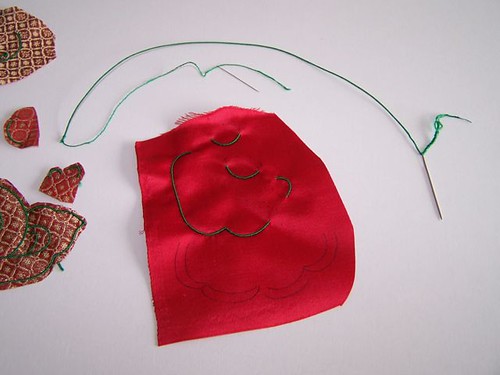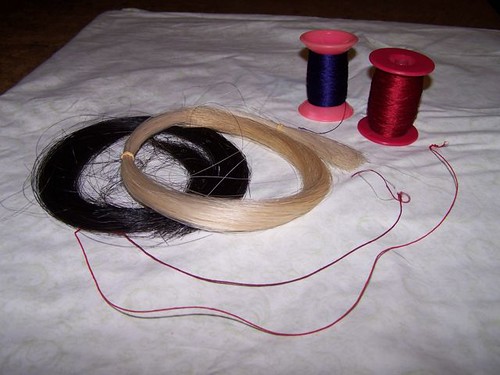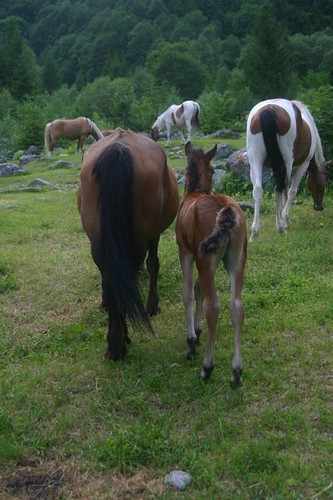
Couched horsehair cord
This may be the second most frequent question I get about my work. The first is “Where do you get the patience?”
The question is actually very easy to answer… now. But it took me quite a while and several adventures to get to that easy answer.
Okay, let me back up. Some of you are asking, “But what do you use horsehair for anyway?”
In the Tibetan appliqué tradition I follow, outlines and contours are formed by colored cords couched to silk cloth. If you saw the film, Creating Buddhas, you know how this works. I make these colored cords by wrapping silk thread around three strands of hair from a horse’s tail.

Silk-wrapped horsehair cords
I had two teachers of the silk thangka tradition.
I worked with the first for several months, learning the fundamentals of the craft — particularly wrapping horsehair with silk thread by hand. My second teacher, who taught me the details and with whom I refined my skills over the course of three years, used nylon fishing line in place of horse hair. This had the advantage of making longer cords. But, having tried both, I found horsehair’s advantages significantly more compelling. The microscopic ridges on the hair grasp the fine filaments of the silk, keeping the thread in place. And the horsehair is wonderfully malleable, following whatever curve I guide it around and folding neatly into crisp points.
So when I set out on my own, I had to acquire some horsehair. I lived in India at the time, in the spectacular mountain town of Dharamsala. I had many Tibetan friends, several of whom were artists. I began by asking my first teacher who must have been in a mischeivous mood.

Horses’ Falcons Jersey tails in use
Leslie: Where can I get horse tail?
T.G.: In Ladakh.
Leslie: But from whom? Where in Ladakh? (Ladakh’s a big place.)
T.G.: Look around and find a sleeping horse. Approach very slowly and clip a few strands from his tail (so as not to deprive him of his fly-swatting ability, of course). But be very careful not to wake him up or you could get injured…
Leslie (discouraged): ha ha ha
T.G. and other friends did generously give me small bundles of horsehair from their own supplies, but the identity of an independent source remained a mystery.
I asked around incessantly and some friends offered solutions. Kristin Blancke and Franco Pizzi led treks in Ladakh and other Himalayan regions. Often horses accompanied their Italian groups to carry bags, tents, food, and other supplies. Kristin put the word out to her horseman colleagues, who agreed that a horsetail would be donated when one of the horses died. Several months later, I received the gift of a dusty, well-used tail donated unwittingly by a very hardworking horse who had passed into the bardo and beyond.
Tsering Nyima loved to play the piwong (a traditional eastern Tibetan stringed instrument) at Losar (Tibetan New Year) and other occasions. The bows he used were made in Tibet, with horsehair. He also acquired a tail for me, carried overland by a refugee from Tibet to Nepal and then on to India. This also was dusty and unavoidably animal.
The last and most impressively real horse tail I purchased was sent by mail in the US from a company selling supplies for Native American Indian crafts. In addition to the dust, this one still had the bone and hide attached. My sensibilities (as a “mostly vegetarian” for many years) were seriously challenged. But that’s not a bad thing.
I appreciated the opportunity to be conscious of the extent to which the beauty of the thangkas I create depends on other beings:
the horses who give their tails,
the silkworms who give their lives,
the weavers who labor in poor conditions,
the teachers who share their knowledge,
and uncountable others who participate in the creation, transport, and sale of the materials I use and the spaces I occupy.
Finally, to my great relief and pleasure, I found a reliable supplier of clean, evenly cut horsehair, which has served me through all the subsequent years. Lacis in Berkeley, CA offers an extensive selection of threads, ribbons, tools and supplies for the textile arts and publishes needlework and costume books, as well. For me, their single most important product is…
* Horse Hair:
“A 1 oz bundle of 22″ clean hair (bundle approximately 3/8″ dia) suitable for braiding, kumi-himo, gimp, etc. Available in white (HP20) $8.00 and black (HP21) $8.00.”
I have no idea what kumi-himo and gimp are but it sure is suitable for making appliqué thangka cords!
Search for “horse” in their online catalog and you’ll find it!


What a great posting of your adventures and explications, your “short” list of all the components which have to converge in order for these incredible works to come together. A couple of these things always pop into my mind as I’m working too. Love the pictures!
Just to let everyone know that my 3 horses just had their tails cut off in September while they were in the pasture. Two of them also had their manes cut, as well.They are friendly horses and trusted people. They have little hair left during fly season and are suffering immensely because someone NEEDED horse hair. This is what people will do to trusting animals to provide the hair and this is where some people get it in British Columbia, Canada. This is not the first time stealing from live horses has happened in this country. When you talk of the lovely things that can be made from horsehair, consider where it came from. Are people sure they know where the horsehair is coming from and do they really care about what is happening to live animals for these pleasures?
Dear Dannie, I’m so sorry to hear about what happened to your horses. That is heartbreaking.
Your comment inspires me to look again and more deeply into the horsehair sources I recommend to my students, to be as sure as possible that it is obtained in compassionate ways. Thank you for re-focusing attention on this.
I wish you and your horses well.
I’m a vegan and very unwilling to support animal exploitation of any kind.
I simply need to know what the common method of procurement is for horse hair vendors. Are the tails recovered from horses going to the slaughterhouse? Are the tails clipped from living Horses that have other reasons to live (other than producing hair and meat, that is), such as riding/pleasure horses, show horses, workhorses? do they crop the entire tail, or are the tails removed in fractions?
your help in this is very much appreciated.
Hi JD,
The tails I got through friends in India and Tibet were all cut from horses who had died naturally at the end of their lives. I can’t say these horses were always well treated while they lived. They were often used as pack animals, carrying loads for villagers and for trekkers in mountain environments with no roads, where the livelihood of people depends on moving goods over rough terrain on their own backs or on the backs of animals. Lives, suffering, comfort, and usefulness are intertwined for all the beings there in unequal and interconnected power relationships
I
Hello, I just noticed your RSS feed isn’t working properly when I attempted to subscribe 🙁 Just an FYI!
The feed for posts works. I’ve never gotten the comment feed to work properly, though. Thanks.
Hi Leslie,
I am in search for reliable horse hair supplier in India. We make gloves for boxing used in fights televised around the world. Originally in the Roman era boxing use to happen with horse hair and these days some people specially ask for it.
Can you recommend a reliable supplier for the same?
Thanks!
Hi Kiran,
I don’t know any horsehair suppliers in India. When I lived in India, I received horsehair from individuals whose horses had passed away. Now I purchase it from suppliers in the US, such as lacis.com and knot-a-tail.com
Good luck!
Leslie
We have sold mane and tail horsehair for the last 26 years and are located in the US.
http://www.hitchingpostsupply.com
You seriously did not say sneak up on a horse a cut its tail. That is by far the the last thing you should do. Anyone sneaking up on my horses to cut tail hair (wether you were joking or not) will be arrested.
Hi Randie,
I certainly did NOT suggest sneaking up on a horse and cutting its tail! I recounted a story of the mischievously obstructive response I received years ago when I tried to get advice from my former teacher. He was joking and, in a decidedly unhelpful way, letting me know that I was on my own in finding a source.
I have never and would never sneak up on a horse.
Be well.
As one of the largest supplies in the United States we have been supplying bulk horsehair since 1988. Please see our web site for lengths and colors. We have mane and tail horse hair. Tail hair from 18″ to 43″. Also how-to books on braiding, hitching, twisting and Kumi Himo.
Thanks, Vickie, for letting us know about your company, Hitching Post Supply (http://www.hitchingpostsupply.com).
If there was a market for it, I would consider selling the horsehair I clip off the body of horses. It does not contain the mane and tail hair you’ve been discussing to date. However this body hair was the type used to stuff furniture in late times. Any suggestions?
Do you sell the silk wrapped horse hair cords?
No, I don’t sell the cords. I make them as I go along in the process of creating a thangka. What were you thinking of using them for, Lynnea?